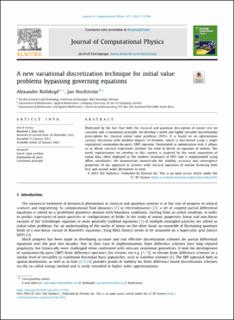| dc.contributor.author | Rothkopf, Alexander Karl | |
| dc.contributor.author | Nordström, Jan | |
| dc.date.accessioned | 2023-10-13T07:50:56Z | |
| dc.date.available | 2023-10-13T07:50:56Z | |
| dc.date.created | 2023-05-18T10:54:26Z | |
| dc.date.issued | 2023-03 | |
| dc.identifier.citation | Rothkopf, A.K. & Nordström, J. (2023) A new variational discretization technique for initial value problems bypassing governing equations. Journal of Computational Physics, 477, 111942 | en_US |
| dc.identifier.issn | 0021-9991 | |
| dc.identifier.uri | https://hdl.handle.net/11250/3096301 | |
| dc.description.abstract | Motivated by the fact that both the classical and quantum description of nature rest on causality and a variational principle, we develop a novel and highly versatile discretization prescription for classical initial value problems (IVPs). It is based on an optimization (action) functional with doubled degrees of freedom, which is discretized using a single regularized summation-by-parts (SBP) operator. Formulated as optimization task it allows us to obtain classical trajectories without the need to derive an equation of motion. The novel regularization we develop in this context is inspired by the weak imposition of initial data, often deployed in the modern treatment of IVPs and is implemented using affine coordinates. We demonstrate numerically the stability, accuracy and convergence properties of our approach in systems with classical equations of motion featuring both first and second order derivatives in time. onvergence properties of our approach in systems with classical equations of motion featuring both first and second order derivatives in time. | en_US |
| dc.language.iso | eng | en_US |
| dc.publisher | Elsevier Ltd. | en_US |
| dc.rights | Navngivelse 4.0 Internasjonal | * |
| dc.rights.uri | http://creativecommons.org/licenses/by/4.0/deed.no | * |
| dc.subject | fysikk | en_US |
| dc.title | A new variational discretization technique for initial value problems bypassing governing equations | en_US |
| dc.type | Peer reviewed | en_US |
| dc.type | Journal article | en_US |
| dc.description.version | publishedVersion | en_US |
| dc.rights.holder | © 2023 The Author(s). | en_US |
| dc.subject.nsi | VDP::Matematikk og Naturvitenskap: 400::Fysikk: 430 | en_US |
| dc.source.volume | 477 | en_US |
| dc.source.journal | Journal of Computational Physics | en_US |
| dc.identifier.doi | 10.1016/j.jcp.2023.111942 | |
| dc.identifier.cristin | 2147994 | |
| dc.relation.project | Sigma2: NN9578K | en_US |
| dc.relation.project | Norges forskningsråd: 286883 | en_US |
| dc.source.articlenumber | 111942 | en_US |
| cristin.ispublished | true | |
| cristin.fulltext | original | |
| cristin.qualitycode | 2 | |

